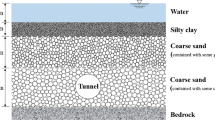Abstract
In order to study the dynamic response of subway trains to adjacent tunnels at different distances, a numerical simulation method was used to establish a refined three-dimensional segment plus orthotropic material tunnel model, and an excitation load was applied on the track bed to simulate Subway moving load. The results show that as the vertical acceleration decreases, the vibration impact range gradually rises from the bottom of the tunnel to the top of the tunnel; the maximum position of the horizontal acceleration is at the waist of the arch, and the peak value increases significantly with the reduction of the net distance. The peak value is 4.25 times when the net distance is 6.0 m; horizontal vibration is the main direction that causes the stress to increase in the parallel short-distance tunnel; the net distance decreases from 6.0 to 4.0 m. Increase, an increase of 131.3%.









Similar content being viewed by others
Data Availability
The data supporting the results of this study can be obtained from the corresponding author upon reasonable request.
References
An L, Li D, Yu P, Yuan P (2016) Numerical analysis of dynamic response of vehicle–bridge coupled system on long-span continuous girder bridge. Theor Appl Mech Lett 6(04):186–194
Bai B, Li C (2009) Elastoplastic dynamic response of parallel tunnels at close distances under subway train vibration. Rock Soil Mech 30(01):123–128
Ding P, Tao L, Yang X, Zhao J, Shi C (2019) Three-dimensional dynamic response analysis of a single-ring structure in a prefabricated subway station. Sustain Cities Soc 45:271–286
Fu Q, Bu M, Xu W, Chen L, Li D, He J, Kou H, Li H (2021) Comparative analysis of dynamic constitutive response of hybrid fibre-reinforced concrete with different matrix strengths. Int J Impact Eng 148:103763
Gharehdash S, Barzegar M (2015) Numerical modeling of the dynamic behaviour of tunnel lining in shield tunneling. KSCE J Civ Eng 19(6):1626–1636
He W, Chen J, Guo J (2011) Dynamic analysis of subway station subjected to internal blast loading. J Cent South Univ Technol 18(03):917–924
Hu Q, Yu H, Yuan Y (2008) Numerical simulation of dynamic response of an existing subway station subjected to internal blast loading. Trans Tian** Univ S1:563–568
Lai J, Wang K, Qiu J et al (2016) Vibration response characteristics of the cross tunnel structure. Shock Vibr. https://doi.org/10.1155/2016/9524206
Le T, Huh J, Park J (2014) Earthquake fragility assessment of the underground tunnel using an efficient SSI analysis approach. J Appl Math Phys 2:1073–1078
Li X, Jiang T, Yue J et al (2011) Application of infinite element boundary in the analysis of environmental vibration induced by subway. Chinese J Undergr Space Eng 7(S1):1377–1383
Li TZ, Yang XL (2018) Probabilistic stability analysis of subway tunnels combining multiple failure mechanisms and response surface method. Int J Geomech 18(12):04018167
Liang B, Luo H, Sun C (2006) Simulation study on vibration load of high-speed railway. J China Railw Soc 28(4):89–94
Mo H, Deng F, Wang J (2006) Analysis of dynamic response of metro shield tunnel in operation period. Chinese J Rock Mech Eng S2:3507–3512
Ramchandani J, Mangulkar M (2016) Comparison between different shapes of structure by response spectrum method of dynamic analysis. Open J Civil Eng 6:131–138
Shao W (2019) Seismic response analysis of subway underground stations using split columns. IOP Conf Series: Earth Environ Sci 218(1):012127
Yan Q, Chen W, Chen X et al (2018) Vibration response characteristics and damage law of trains in close vertical overlap shield tunnels. China Railw Sci 39(04):78–84
Yang M, Men Y, Yuan L et al (2016) Numerical analysis of subway vibration response of different tunnel types under ground fissure environment. J Disaster Prev Mitig Eng 36(02):188–195
Yang DJ, Li Ya (2012) Seismic response analysis of subway station in tian** soft soil area. Appl Mech Mater 166:2171–2176
Zheng G, Li Z (2012) Finite element analysis of the influence of pit angle effect on the surrounding buildings of foundation pit. J Tian** Univ 45(08):688–699
Author information
Authors and Affiliations
Contributions
YL: Investigation—editing and supervision; XD: writing, editing—data analysis and original drafts; XL: writing—editing and checking.
Corresponding author
Ethics declarations
Conflict of interest
The authors do not have any possible conflicts of interest.
Additional information
Publisher's Note
Springer Nature remains neutral with regard to jurisdictional claims in published maps and institutional affiliations.
Rights and permissions
About this article
Cite this article
Li, Y., Du, X. & Li, X. Analysis of Dynamic Response of Subway to Adjacent Tunnel with Different Clear Distances. Geotech Geol Eng 39, 5173–5181 (2021). https://doi.org/10.1007/s10706-021-01822-y
Received:
Accepted:
Published:
Issue Date:
DOI: https://doi.org/10.1007/s10706-021-01822-y




